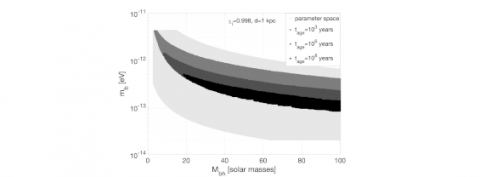Direct Constraints on the Ultralight Boson Mass from Searches of Continuous Gravitational Waves

Among the most promising candidates to explain dark matter there are hypothetical ultralight bosons, like axions, that would be also able to solve some theoretical problems in the current Standard Model of particle physics. If they exist, these particles could form large clouds around astrophysical black holes, at the expense of the black hole mass and angular momentum. Once formed, such clouds are expected to slowly dissipate by emitting long-lasting periodic gravitational waves. By analysing data from the second run of the Advanced LIGO detectors, researchers from INFN and Sapienza have been able, for the first time, to set experimental constraints on the ultralight boson mass. By using cutting-edge data analysis techniques, researchers from INFN and Sapienza, belonging to the LIGO-Virgo Collaboration, have excluded the presence of periodic gravitational wave signals strong enough to be detected, given current detector sensitivity, and have used the resulting upper limits on the signal strain amplitude to exclude a range of ultralight boson masses. The results of this study have been recently published in Physical Review Letters. The analysis of new, more sensitive, data from Advanced LIGO-Virgo detectors, will ultimately help to shed more light on the fascinating connections among particle physics and black holes.
Reference
Phys. Rev. Lett. 123, 171101 (2019)
Authors
C. Palomba, S. D’Antonio, P. Astone, S. Frasca, G. Intini, I. La Rosa, P. Leaci, S. Mastrogiovanni, A. L. Miller, F. Muciaccia, O. J. Piccinni, L. Rei, and F. Simula
